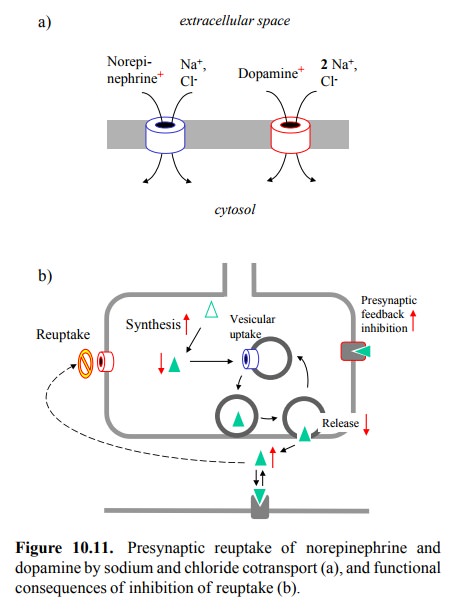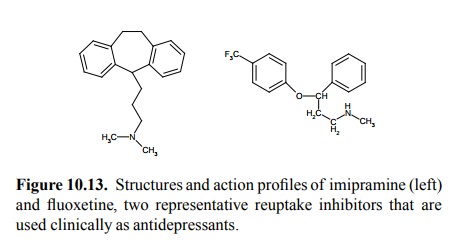Chapter: Biochemical Pharmacology : G protein-coupled receptors
Inhibitors of presynaptic transmitter reuptake
Inhibitors of presynaptic
transmitter reuptake
Presynaptic reuptake of
catecholamines works by cotrans-port of sodium and chloride ions. While the
reuptake trans-porters are homologous among the various types of
cate-cholaminergic and serotoninergic synapses, the stoichiom-etry of
transmitter molecules and co-transported ions ap-pears to vary, as depicted in
Figure 10.11a. The transport process is facilitated both by ion concentration
gradients and by the resting membrane potential (note that reuptake will cause
a net transport of positive charge to the cytosol). Inhibition of presynaptic
transmitter reuptake is another very important principle of drug action at
adrenergic and serotoninergic synapses. It will have several consequences
(Figure 10.11b):

1. It will increase the concentration of transmitter
in the synaptic cleft and, therefore, the postsynaptic stimulato-ry action.
2. The postsynaptic cells will respond with a
reduction of receptors exposed on the surface. This is one of the ef-fects
leading to a fairly rapid and noticeable decrease in drug efficacy, and to
habituation and possibly ad-diction.
3. It will
increase the presynaptic negative feedback, reducing both the rate of
transmitter release and (by regulation at the genetic level) the amount of
synthetic enzymes, e.g. of tyrosine hydroxylase.
4. The intracellular pool of transmitter will be
depleted.
5. This will disinhibit tyrosine hydroxylase at
the protein level, and therefore the actual turnover of synthesis will be
increased, despite the reduced prevalence of synthetic enzymes.
Again, there are various
drugs with different ranges and specificities. Cocaine has a particularly broad
spectrum, affecting the reuptake of norepinephrine, dopamine, and serotonin
alike. The effect of cocaine can be quantita-tively studied in mice by
observing their excitement in re-sponse to being placed into a new environment,
which is measured simply as the distance travelled within their new home over
time. In experiments with transgenic mice, the reuptake transporters for both
dopamine and serotonin had to be deleted in order to abolish the increase in
excitement induced by cocaine.
In
humans, a prominent effect of cocaine consists in in-creased vigilance and
elevated mood. While cocaine itself is not used clinically, several
catecholamine and serotonin reuptake blockers are used as antidepressants.
Imipramine (Figure 10.13) is a `classic' but not so very specific; in ad-dition
to inhibiting the reuptake of serotonin and of nore-pinephrine, it also has
antihistaminic and antimuscarinic5 activity. This will lead to side
effects in both the central nervous system and the peripheral autonomic system.
A prominent one is the causation or deterioration of cardiac arrhythmias due to
its antimuscarinic action.

Imipramine
and its many structurally similar congeners are collectively referred to as the
`tricyclic antidepressants'. A more modern drug is fluoxetine, which has
similar an-tidepressant action but lacks most of the side effects of
imipramine. Its selectivity for serotonin reuptake supports the notion that
this transmitter, indeed, has a major role in regulating mood.
Since
inhibition of transmitter reuptake depletes both the presynaptic transmitter
and the postsynaptic receptors, it is clear that immediately after sudden
discontinuation of a reuptake inhibitor the level of postsynaptic excitation
would be very much reduced. Therefore, termination of antidepressant therapy
must always be done carefully and slowly.
Related Topics